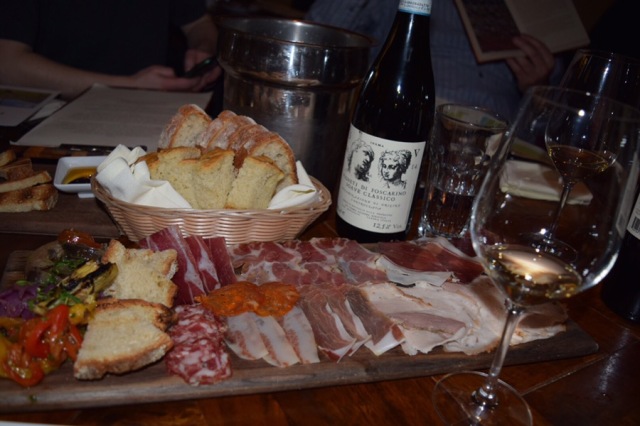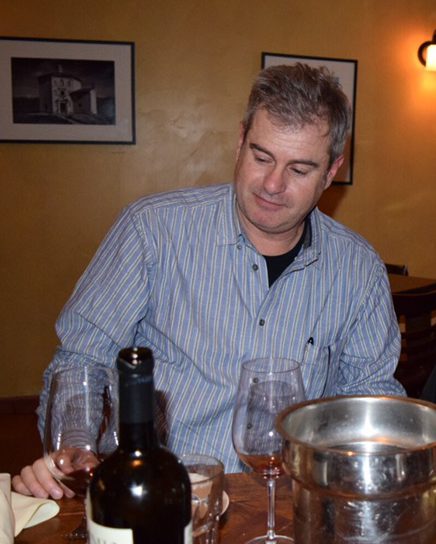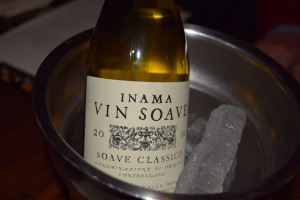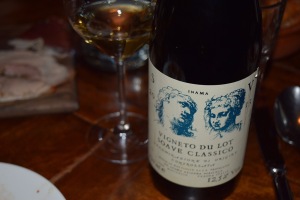Until a couple of years ago, I really did not have much time for Italian white wines in general and whites from the Soave region in particular. For the most part, I found the wines rather fat (i.e., lacking acidity) and frankly pretty boring (i.e., lacking much flavor or character).
A lunch in New York with Lisa Anselmi a little over a year ago started to chisel away at that perception of wines from the region, so when Jason Wilson contacted me about a tasting of Soave wines from another leader in the region, I was intrigued. When he then told me that the tasting was at Le Virtù in Philadelphia, it was a complete no-brainer.
The winemaker? Inama’s Stefano Inama.
Coincidentally, it was Inama’s founder (and Stefano’s father), Giuseppe Inama who had spent 35 years working as the enologist at Anselmi while simultaneously trying to establish his own Inama label. Giuseppe left Anselmi in 1983, which enabled him to focus solely on his own wines and winery.
There is certainly a story behind the Inama/Anselmi break-up (which apparently involves the destruction of furniture), but like most people I have met in the wine industry, Stefano had little interest discussing that part of the past when at present there were open bottles and plenty of food on the table.

Soave Classico and affettati misti. Whoa.
Stefano, who by any interpretation is certainly gregarious with firmly held opinions, started making wines for his father in the 1990’s and took over as head of the company when his father died in 2009. After only a few minutes at the table, it was clear that Stefano Inama is the kind of guy that I could spend several days with and he would never run out of stories or opinions, but I would quickly run out of notebook paper.

Stefano in a reflective mood.
Today, Inama (along with Anselmi and a third producer in the region, Pieropan), is at the forefront of changing the perception of both Garganega and Soave, a grape and a region often associated with the production of rather boring, bland, bulk wines.
As I soon found out, Inama’s wines are far from boring. In fact, they are among some of the best wines I have ever tried from Soave. And his Bonomio wines from Montelpulciano (about 500 kilometers from Soave), were incredible.
 2014 Inama Soave Classico: Retail $14 in PA, $12 in NJ. 100% Garganega. 25 thousand cases produced, which represents about half the winery’s production. Great Garganega nose of lemon and melon. Round and rich on the palate according to Stefano “a bit warm for drinking but good for tasting.” Very Good. 87-89 Points.
2014 Inama Soave Classico: Retail $14 in PA, $12 in NJ. 100% Garganega. 25 thousand cases produced, which represents about half the winery’s production. Great Garganega nose of lemon and melon. Round and rich on the palate according to Stefano “a bit warm for drinking but good for tasting.” Very Good. 87-89 Points.
2014 Inama Soave Classico Vigneti di Foscarino: Retail $23. 100% Garganega. One of the newly designated Crus of Soave. From vines of the east facing slopes of Mount Foscarino, an area planted to the vine for 2000 years, on the only volcanic soils in northern Italy. This wine is richer on both the nose and palate with intense flavors including some pineapple and lemon rind. Excellent. 89-91 Points.

The Vignette du Lot was magnificent.
2013 Inama Soave Classico Vigneto do Lot: Retail $25? 100% Garganega. This one has more of a south-facing exposure on Mount Foscarino and is therefore known as the “wine of heat” as the exposure creates a much warmer vineyard. Slightly more expressive nose than the Vigneti di Foscarino, predominantly floral in nature. Surprisingly, more minerality here with weight and depth, followed by a lengthy finish. Just short of a whoa. Excellent. 91-93 Points.

2012 Inama Carménère Pui: Retail $19. 70% Carménère, 30% Merlot. Under screw cap but this is the only year that they did that–does not develop so they switched back to cork. Pui means “plus” or “more” as this has some Merlot added for a bit of “civilizing influence” according to the website. A bit green on the nose but on the palate? Holy cow. Rich and full without smacking you in the face. Plenty of attitude as well. $20? You bet. Excelltent to Outstanding. 91-93 Points.
In the late 1990’s, Stefano entered into a partnership with Fattoria La Valentina, a relatively new operation in Abruzzo, to produce wine from the Binomio vineyard, which is solely planted to Montelpulciano. The results have been stunning.
2010 Binomio Montelpuciano d’Abruzzo: Retail $48. Deep red color and wild blackberry aromas. On the palate, it has a ripasso/Amarone-like element with stewed fruit and a luscious mouthfeel. This is hedonistic and wonderful. Outstanding. 92-94 Points.
2011 Binomio Montelpulciano d’Abruzzo: Retail $48. A more standard expression as it is more reserved initially but as it progressed? Holy crap. Whoa. This is firmly in the 92-94 Points range as well but for different reasons. This is much more introspective and deep, requiring contemplation. A wine geeks wine. Outstanding.








Have always enjoyed the Soaves but the Carménère is Inama’s secret weapon. The Bradisismo and single vineyard Carménère are also stand-out reds.
LikeLike
Soave is changing, that’s for sure! Hope it can shake off the bargain basement it tends to have in the UK for bottom of the shelf stuff.
LikeLiked by 1 person
With each Soave I have, I think the same thing–they have a lot of work to do to change that perception still, but they are doing it the right way!
LikeLiked by 1 person
That’s true, it’ll take a lot of hard graft and so-so bottles before they get there.
LikeLike
In the mean time, the prices of the “good” producers will hopefully remain low-ish.
LikeLiked by 1 person
Haha! Yes, that’s important too
LikeLike
Yeah, that Carménère was hauntingly good!
LikeLike
Glad to see this region’s smaller producers–and, as a result, the real wines of the region–getting some recognition. It’s no accident those flat, less than compelling wines dominate perceptions of Italian whites, as there’s a metric ton of essentially jug wines from the area getting produced, but like everything else in Italy the “real thing” is there waiting to be found, and it will defy your biases every time by being amazing.
Check out Monte Tondo as well. Inama is good, Monte Tondo’s even better.
LikeLiked by 1 person
I have not hidden my malaise concerning Italian whites, but that is certainly changing. I wish more of the really good stuff were more readily available. Will have to search the Monte Tondo out!
LikeLiked by 1 person
Indeed, a big part of the problem is laziness on the part of the importers. The reason even really decent wine stores will have shelf after shelf flooded with generic Pinot Grigio, Chardonnay, and Sauvignon offerings with nary a Gavi or Lugana or Greco di Tufo to be found isn’t necessarily lack of interest, but lack of choice in what wine reps are offering up.
LikeLiked by 1 person
That’s really a great point that I am sure that many people don’t consider. For importers I imagine it is a lot easier to fill a container from one producer than to cobble together 1200 cases from several smaller producers. Thus, we end up seeing a lot more wine that has that mass-produced taste to it….
LikeLiked by 1 person
Jumping on the Soave bandwagon – I too have had similar lackluster Italian white experiences – but will revisit. The Italians sure know how to put on a good spread – that table of food was to die FOR! Cheers! Xo
LikeLiked by 1 person
Yeah, the food was crazy.
LikeLiked by 1 person